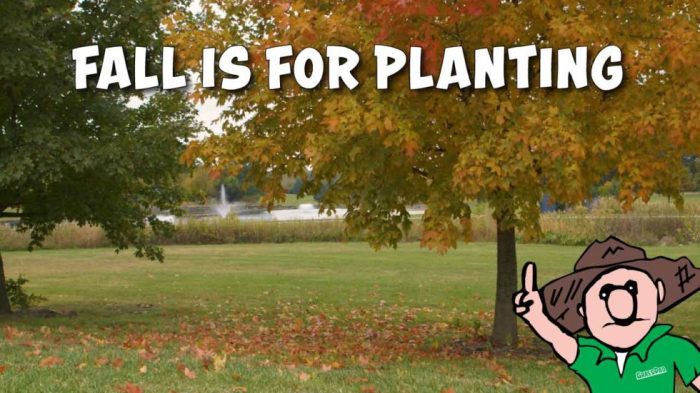Tree Species and Their Planting Requirements

When should you plant a tree – Choosing the right tree for your landscape is paramount to its success. Understanding the specific needs of different species, particularly the differences between deciduous and coniferous trees, is crucial for ensuring healthy growth and longevity. This section will delve into the planting requirements of various tree types, focusing on soil preparation and specific planting instructions for optimal results.
Deciduous and Coniferous Tree Planting Needs
Deciduous trees, such as oaks and maples, lose their leaves annually, while coniferous trees, like pines and firs, retain their needles year-round. This fundamental difference impacts their water requirements and overall planting needs. Deciduous trees generally prefer well-drained soil and can tolerate a wider range of soil conditions. Coniferous trees, on the other hand, often thrive in slightly acidic soil with excellent drainage, and some species are more tolerant of drought.
Proper soil preparation is essential for both types, focusing on aeration and nutrient content.
Soil Preparation for Various Tree Types
Soil preparation is the foundation for successful tree planting. Before planting any tree, it’s vital to analyze your soil. A soil test can determine its pH, nutrient levels, and drainage capacity. Amendments, such as compost, peat moss, or other organic matter, can improve soil structure, drainage, and fertility. Clay soils benefit from the addition of organic matter to increase aeration and drainage.
Sandy soils, conversely, may require the addition of organic matter to improve water retention. For trees with specific pH preferences, soil amendments like lime (to raise pH) or sulfur (to lower pH) may be necessary. Always ensure adequate drainage to prevent root rot.
Planting Instructions for Specific Tree Species
Let’s examine the planting instructions for three common tree species: oak, maple, and pine. Remember, these are general guidelines, and specific requirements may vary based on the cultivar and local conditions.
Planting an Oak Tree
Oak trees prefer well-drained, slightly acidic soil. Dig a hole twice as wide as the root ball, but only as deep. Amend the soil with compost before planting. Gently loosen the roots of the sapling before placing it in the hole. Backfill with the amended soil, ensuring no air pockets remain.
Right, so best time to chuck a tree in the ground? Autumn’s usually a solid shout, gives it time to settle before spring. But if you’re thinking about a rubber plant, check out this guide on propagating a rubber tree plant first, cos that’ll give you a head start. Then, once you’ve got your little rubber tree sorted, remember the autumn planting rule – get it in the earth before the frost bites!
Water thoroughly after planting.
Planting a Maple Tree
Maple trees also appreciate well-drained soil, but they are more tolerant of various soil types. Follow the same hole-digging and backfilling techniques as for oak trees. Maple trees benefit from regular watering, especially during dry periods.
Planting a Pine Tree
Pine trees thrive in well-drained, slightly acidic soil. Dig a hole slightly larger than the root ball. Avoid planting the tree too deeply; the root flare should be visible at ground level. Backfill with the native soil, and water thoroughly after planting. Pine trees are generally more tolerant of drought once established.
Site Selection and Preparation

Planting a tree is a significant act, a commitment to the future. Choosing the right location and preparing the site properly are crucial steps that will directly influence the tree’s health, longevity, and overall success. Neglecting these initial phases can lead to stunted growth, disease susceptibility, and ultimately, the failure of your planting efforts. Let’s ensure we lay the foundation for a thriving tree!The success of your tree planting hinges on careful site selection and meticulous preparation.
We’ll explore the key factors that determine the ideal location for your tree, along with the essential steps to prepare the planting site for optimal growth. Remember, a little extra effort upfront will yield significant rewards in the years to come.
Sunlight Exposure and Proximity to Structures
Sunlight is essential for photosynthesis, the process by which trees produce energy. Different tree species have varying sunlight requirements; some thrive in full sun, while others prefer partial shade or even full shade. Before planting, research your chosen tree’s sunlight needs. Consider the sun’s path throughout the day to determine the amount of sunlight the location receives.
Also, ensure adequate spacing from buildings, driveways, and walkways to prevent future conflicts with roots or branches. A mature tree’s root system can extend far beyond its canopy, potentially damaging structures if planted too close. For example, a large oak tree should be planted at least 20-30 feet away from a house to avoid root intrusion into foundations.
Underground Utilities
Before digging, always contact your local utility companies to locate underground lines. Hitting a gas line, water main, or electrical cable can be dangerous and costly. Most utility companies offer free services to mark the location of underground utilities. This is a crucial step to prevent accidents and ensure the safety of both yourself and the surrounding environment.
This simple precaution can save you significant time, money, and potential harm.
Soil Testing and Interpretation, When should you plant a tree
Soil testing is a fundamental aspect of successful tree planting. It provides invaluable insights into your soil’s composition, including pH level, nutrient content, and drainage capacity. A soil test will reveal whether your soil is acidic, alkaline, or neutral, which directly affects a tree’s ability to absorb nutrients. Nutrient deficiencies can lead to stunted growth and vulnerability to diseases.
Poor drainage can suffocate roots, resulting in root rot and tree death. Many local agricultural extension offices offer affordable soil testing services, providing detailed reports and recommendations for soil amendments. Interpreting the results involves understanding the optimal pH range and nutrient requirements for your chosen tree species. Amendments like compost, peat moss, or other organic matter can be added to improve soil structure, drainage, and nutrient content based on the test results.
For example, if the soil test reveals low phosphorus, adding a phosphorus-rich fertilizer can help address this deficiency.
Preparing the Planting Site
Preparing the planting site is a crucial step to ensure your tree’s success. This involves several steps designed to create an ideal environment for root establishment and growth.
- Clearing the Area: Remove any existing vegetation, rocks, and debris from the planting area. This creates a clean space for planting and prevents competition for resources.
- Weed Removal: Thoroughly remove weeds and their roots to minimize competition for water and nutrients. Persistent weeds can severely impact a young tree’s ability to establish itself.
- Soil Amendment: Based on your soil test results, amend the soil with organic matter, such as compost or peat moss, to improve drainage, aeration, and nutrient content. This will create a rich and fertile environment for your tree’s roots to thrive.
- Digging the Planting Hole: Dig a hole twice as wide and as deep as the tree’s root ball. This allows for ample space for root expansion and prevents root circling, a common problem that restricts growth.
Planting Techniques and Aftercare: When Should You Plant A Tree

Planting a tree is only half the battle; ensuring its survival and thriving requires diligent aftercare. The success of your tree, its longevity, and its contribution to the environment depend heavily on the techniques used during planting and the subsequent care it receives. Let’s equip ourselves with the knowledge to nurture these vital members of our ecosystem.Proper planting techniques minimize transplant shock and establish a strong foundation for future growth.
Neglecting aftercare, however, can negate all the effort put into the initial planting process. Remember, we’re not just planting a tree; we’re investing in a future that includes cleaner air, a healthier environment, and a legacy for generations to come.
Planting Techniques
The success of your tree planting hinges on careful handling and precise placement. Begin by gently removing the tree from its container, taking care not to damage the delicate root system. Examine the root ball; if roots are circling, gently loosen them to encourage outward growth. Dig a hole twice as wide as the root ball, but only as deep.
This allows the roots to spread easily and prevents them from becoming waterlogged. Position the tree in the hole, ensuring the top of the root ball is level with the surrounding ground. Backfill the hole with the excavated soil, gently firming it around the base of the tree to eliminate air pockets. Avoid compacting the soil too tightly, as this can restrict root growth.
Imagine you are carefully tucking the tree into its new home, providing a supportive and comfortable environment.
Post-Planting Care
Providing consistent care is paramount for a newly planted tree’s survival. This involves a multi-pronged approach, combining watering, mulching, and potentially staking.
The importance of consistent watering cannot be overstated. Newly planted trees are especially vulnerable to drought stress. Water deeply and regularly, especially during dry spells. The frequency and amount will depend on factors like weather conditions, soil type, and tree species, but aiming for a slow, deep watering that soaks the root ball thoroughly is crucial.
Mulching helps retain soil moisture, suppress weeds, and regulate soil temperature. Apply a 2-3 inch layer of organic mulch, such as wood chips or shredded bark, around the base of the tree, keeping it a few inches away from the trunk to prevent rot.
Staking may be necessary for young trees, especially those planted in windy areas. Use flexible stakes and tree ties to provide support without constricting the trunk. Remove stakes after a year or two once the tree is established.
Watering Techniques
Visualize this: A newly planted tree, its root ball nestled comfortably in the soil. Instead of a quick, shallow watering that only wets the surface, imagine a slow, gentle soaking. Picture a circle of water, approximately twice the diameter of the root ball, slowly seeping into the ground. This deep, slow watering ensures the water reaches the roots, hydrating them thoroughly and encouraging deep root growth.
The frequency depends on weather conditions; during hot, dry spells, you might water every few days, while during cooler, wetter periods, you may only need to water once a week or less. The key is to feel the soil – if it’s dry several inches down, it’s time to water. Avoid overwatering, as this can lead to root rot.
The goal is to provide consistent moisture without creating waterlogged conditions. Imagine a sponge – you want it damp, not soaking wet.
Question Bank
What type of tree is best for my small garden in Pontianak?
Consider smaller, faster-growing trees like frangipani or certain varieties of fruit trees that won’t overwhelm your space.
How often should I water a newly planted tree?
Deeply water your newly planted tree regularly, especially during dry spells. The frequency depends on the weather, but aim for consistent moisture.
What should I do if my tree isn’t growing well?
Check the soil moisture, sunlight exposure, and look for signs of pests or diseases. If problems persist, consult a local gardening expert.
Can I plant a tree during the rainy season in Pontianak?
Yes, but ensure proper drainage to prevent root rot. Choose a location with good drainage and avoid planting in areas prone to waterlogging.

